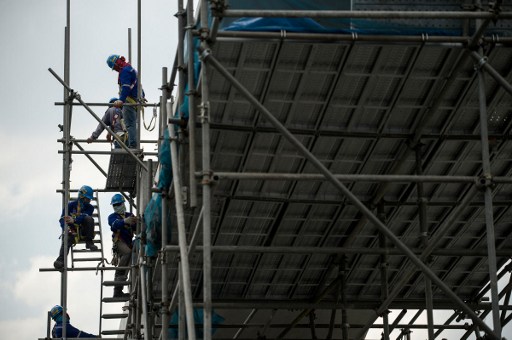PH experiencing ‘golden age of economic growth’- ADB exec

AFP PHOTO
The Philippines is currently experiencing a “golden age of economic growth” amid sustained expansion in over five decades, an executive of the Asian Development Bank said on Wednesday, with the Duterte administration’s ambitious infrastructure program seen not only boosting the gross domestic product but also reducing poverty incidence.
In its Asian Development Outlook 2018 report released also on Wednesday, the Manila-based multilateral lender kept its 6.8-percent GDP growth forecast for the Philippines for 2018, a faster pace than the 6.7-percent actual expansion in 2017.
For 2019, the ADB projected the Philippine economy to further grow by 6.9 percent, although the forecasts in the next two years were below the government’s target range of 7-8 percent starting this year until 2022.
“Rising domestic demand, remittances, and employment, in addition to infrastructure spending, will drive growth” in the Philippines in the near term, the ADB said in a statement.
“Along with domestic demand, the government’s infrastructure investments will fuel the country’s growth in the next few years, supported by a sound economic policy setting. We expect this growth to further lift wage employment numbers, add to household incomes, and benefit more poor families across the archipelago,” Kelly Bird, the ADB’s new country director for the Philippines, was quoted in the statement.
Article continues after this advertisementBird told reporters that he believes the Philippines is now on its “golden age” as economic growth has been achieved for over 50 years.
Article continues after this advertisementFor Bird, economic expansion will be sustained in 2018 and 2019 as “reforms are in place to support the government’s infrastructure plan,” referring to the massive “Build, Build, Build” program.
Under “Build, Build, Build,” the government plans to roll out 75 “game-changing” projects, with about half targeted to be finished within President Duterte’s term, alongside spending a total of over P8 trillion on hard and modern infrastructure until 2022 in a bid to usher in the “golden age of infrastructure.”
Bird added that “the government has very sound economic policies in place that will help mitigate external risks.”
“Moving forward, the ADB projects services will continue to drive GDP growth, along with manufacturing and construction industries,” the lender said.
“The approval of the Tax Reform for Acceleration and Inclusion [TRAIN] Law in December 2017 will augment tax revenues and provide additional fiscal space for more progressive public spending. The policy reforms are expected to yield additional P90-144 billion in tax revenue collection in 2018 and 2019, respectively,” it added.
According to the ADB, “there are external risks to the Philippines’ growth outlook from heightened volatility in international financial markets and uncertainty about global trade openness, although the country’s strong external payments position would cushion these effects.”
Bird said that the Philippines’ economic golden age “occurred in a sound macroeconomic policy environment.”
“This one has occurred with relatively moderate inflation. The fiscal position is very strong—it had a [budget] deficit of 2.2 percent of GDP last year. You’ve seen national government debt as a share of GDP decline, it’s around 42 percent now—it’s the lowest level in terms of its share of GDP for 20 years.
You’ve got the credit ratings that show the Philippines is at investment grade rating. We’re also seeing a labor market that has grown robustly,” Bird said.
“When you look at all those factors together, it’s quite a virtuous cycle. That’s why I would call it’s a golden age for the Philippines because it’s growing in a very sound macroeconomic policy framework,” Bird added.
Bird also attributed the high economic growth in recent years to the central bank and fiscal institutions, which for him were “very strong institutions that had put in place measures to mitigate against risks to the economy.”
“I think the infrastructure plan will help sustain that over the next two to three years. I think it’s important to do that to chip away at the poverty rate, which is still relatively high for a middle-income country,” according to Bird.
The poverty incidence rate stood at 21.6 percent in 2015, and the Duterte administration aims to slash it to 14 percent by 2022 through its 10-point socioeconomic agenda.